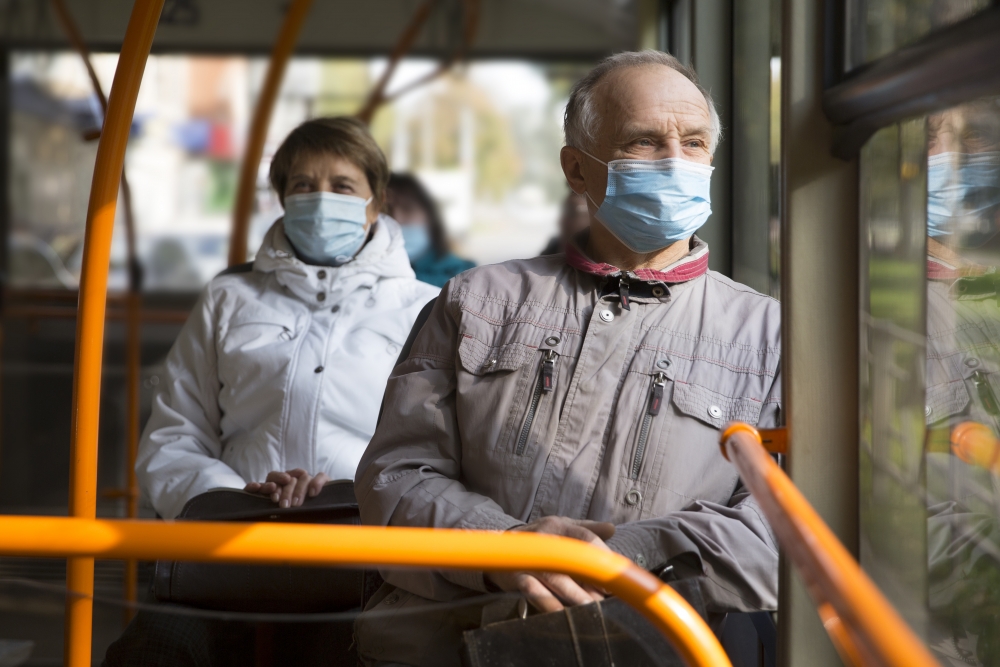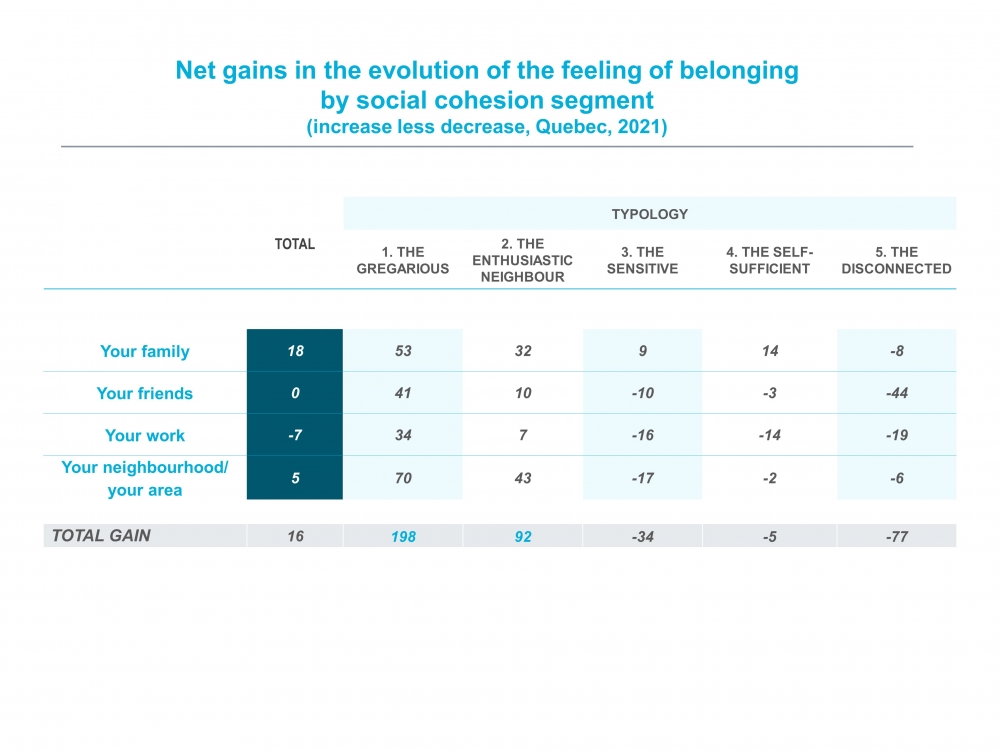Or the emergence of a new human connection
(In collaboration with The Instititut du Nouveau Monde)

The pandemic’s track record
In its darkest hours, the COVID-19 crisis has been a major source of worry for most people. Anxiety and distress for some, weariness and frustration for others; very few were invigorated by the lockdowns (even if some were).
In January 2021, one of our surveys for La Presse revealed that nearly three out of four Quebecers (72%) were worried about the spread of COVID-19. Half (50%) were afraid of catching it!
But beyond concerns specifically about the disease itself, one of the biggest issues for people was the social isolation.
In this survey we conducted for the Institut du Nouveau Monde in June 2021, we found that three out of five Quebecers (62%) felt the need to develop new relationships in order to overcome the forced isolation they had endured for more than a year. What's more, 44% reported taking concrete steps over that same period to develop these new relationships.
People have undeniably suffered from the isolation imposed by public health measures. They have felt the need to make new contacts, develop new connections. They have needed to connect with others during this crisis. They have needed people to talk to, to listen. They have looked to others for comfort.
The pandemic has produced a need for connection in its absence.
One in two Quebecers (49%) reported that they have needed the support of their friends and family in the past year. Six out of 10 (60%) felt that their friends and family also have needed support during the same period. These data say a great deal about the social malaise we have experienced.
Clearly, the way to fulfill this need for connection differs greatly from one person to another, especially when one considers the intensity of the need and the object of this connection.
Some have grown closer to their family, both emotionally and virtually. Others have grown closer to co-workers and even to their local community and neighbours. Conversely, others have become emotionally distanced from these same groups, depending on their reaction to the lockdown.
The following graph eloquently expresses this dynamic.

Overall, Quebecers reported that their sense of closeness to their family had increased: 28% considered it to have increased, while 10% thought it had decreased, for a net gain of 18 points!
The net gain is zero for friends, compared to a net 4-point gain in their sense of belonging to their neighbourhood community.
Note, too, that the percentage of Quebecers reporting a weaker sense of belonging to their job was higher than for those reporting a stronger feeling (net -7 points). The impossibility of working in-person with colleagues has undoubtedly had a negative effect on their attachment to their job.
On balance, however, our data lead to the conclusion that our social connections have improved. Despite, or perhaps because of, the pandemic, our social fabric seems to have developed a more emotionally intense cohesion.
At the forefront of these new connections: young people and families.
Not only is it very interesting to observe this strengthening of social cohesion, but it is even more interesting to see who is taking the lead in this respect.
Demographically, we find a significantly higher percentage of parents with children living at home, individuals under 35 and, to a certain extent, people who have a dog!
As well, nearly three out of 10 Quebecers (28%) reported being actively involved in their community. Again, young people under 35, parents with children at home and dog owners are the most active! Moreover, among those involved in their community, social cohesion is at the highest level! For these already more involved individuals, the lockdown seems to have acted as a catalyst for new connections.
It is also very interesting to observe the net gain in the sense of belonging by sociodemographic segment.

Once again, young people with families stand out, as do those involved with their community.
This crossover of traits that reveals important differences in the strength of socialization also tells us that these different behaviours and attitudes are supported by latent trends that stimulate this need for connection.
Different social interactions associated with changes in cohesion.
Probing deeper into these latent trends and underlying factors reveals significant differences in how people perceive their relationships and what they expect from others. Differences that perfectly illustrate the transformation in social cohesion caused by the pandemic.
Five types of individuals have emerged from this exercise:

1. The Gregarious (11%):
In order to thrive, they have a profound need for others. They need to engage in dialogue and share with others, and to maintain and develop meaningful relationships. The pandemic has been particularly hard for these individuals. During this period, they have actively sought to develop new relationships and the quality of their relationships have improved enormously! They are over-represented by people 18-34, couples with children (again, families with a dog!) and those with an above-average level of education.
2. The Enthusiastic Neighbour (10%):
Their relationship with their neighbours and local community has greatly improved. This is also true, to a lesser degree, of their relationship with family and friends. However, they are not involved in their community. The pandemic has led them to socialize more with neighbours and others in their immediate locality and to find a new source of local identity, but without necessarily getting involved. This segment is over-represented by people 55 and over.
3. The Sensitive (40%):
Their need to maintain and develop meaningful relationships is similar to The Gregarious, but in a less characteristic way. The pandemic has been hard for The Sensitive, too. They have also actively sought to develop new relationships and the quality of their relationship with family members has improved significantly, unlike with friends, colleagues and neighbours with whom their sense of closeness has diminished. The quality of their relationships seems to have improved with only a select group of people. The Sensitive are over-represented by people 18-34 and couples with children (and, again, with a dog).
4. The Self-sufficient (35%):
They haven’t missed anyone! The pandemic has not created a social vacuum for them. They are very self-sufficient. Their sense of closeness to family has increased significantly, but their relationship with other groups has generally remained unchanged throughout the COVID-19 crisis. They are over-represented by retirees and people 65 and over.
5. The Disconnected (4%):
The pandemic has clearly isolated them from their entire social life. Their sense of closeness to family, friends, their neighbourhood and their job has declined sharply, even though they were already at a very low level compared to the overall population. They tend to be men, 35-54 years of age, living alone and in the lowest income brackets.

A very positive record!
The purpose of this exercise was to synthesize, in the most holistic way possible, all the various forms of need for human connection that the COVID-19 pandemic has either caused or altered.
When we combine the types of individuals whose social connections have grown stronger, whether with family, friends, colleagues, neighbours or relatives from whom they sought comfort, the balance sheet appears to be very positive. Indeed, the sum of segments 1 to 3 totals 61% of the adult Quebec population; that’s three out of five people, a clear majority! Only 39% did not follow the crowd in their increase in empathy.
It seems, then, that one of the pandemic’s legacies is a new type of humanism. With the restrictions and lockdowns occasioned by public health measures, a need for other people inevitably emerged. Isolation aroused a need for connection, just as losing a coveted object makes it even more desirable. And the joy that comes with the lifting of most of the restrictions can only give an additional boost to the expression of this need for connection.
Keep the gains!
These indicators suggest that a certain strengthening in social cohesion has arisen amidst the COVID-19 maelstrom. A cohesion that will probably persist in the short to medium term, given the social and emotional catch-up that will inevitably occur.
But what about over the longer term?
When the bonds of closeness with family, friends, colleagues and the fellow citizens in one’s neighborhood are strengthened, social cohesion can only benefit. If it took a pandemic to increase social cohesion, we’ll take it as a consolation prize.
But will these levels of belonging and closeness endure? Can the new level of cohesion occasioned by this burst of attachment be maintained? Can we use this pandemic legacy as a springboard to a more empathetic society?
Governments have never been more generous. Will they be able to backpedal when the time comes to manage their credit ratings with institutional creditors? Will voters allow it?
Public health agencies have regulated people’s social interactions very rigorously to control the ravages of the pandemic and imposed strict limits on social gatherings. Can our public institutions, companies and even brands now begin to encourage public gatherings again? Cities can certainly enhance public spaces, meeting places and encourage citizen participation. Companies can do likewise at their workplaces. By organizing events. By optimizing the way we live together.
Our society will emerge transformed from this social and health crisis. We will have to wait and see what direction it will take: more humane or more Darwinist?
Young people, especially those with families, are particularly promising. Their community involvement, their sensitivity to others and their willingness to connect offer a ray of hope. It remains to be seen whether they will maintain this engagement as they age.
How the future unfolds is yet to be determined. We can only hope that things continue to go in this direction.